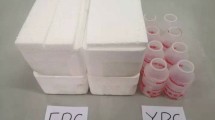Abstract
The pyrolysis process of polystyrene (PS) has been investigated to find optimal temperature profiles which minimize the reaction time and the reaction energy required for a given conversion in a batch reactor. Assuming that the fragmentation of PS in pyrolysis is described by the mechanism of random and/or specific degradations, we used a continuous kinetic model for solving three moment equations to determine the transient change of molecular weight distributions (MWD) of the polymers. We then converted this independent-variable minimization problem using a coordinate transformation to a dependent-variable minimization problem that yields the optimal temperature profiles as its solution. The optimization results obtained in this study encompass the cases of different objective functions which cover minimum reaction time, minimum energy consumed, or any combination of these. It has turned out that maintaining the reaction temperature constant at an optimal level is the best solution in this optimization problem. An economic cost function also has been introduced as the third objective function to be minimized in addition to the reaction time and the reaction energy. This new function can serve as a convenient measure to judge the performance of the pyrolysis process minimizing the involved cost.
Similar content being viewed by others
References
Flynn, J. H. and Florin, R. E., “Degradation and Pyrolysis Mechanisms,” Pyrolysis and GC in Polymer Analysis, Liebman, S. A. and Levy, E. J., Eds., Marcel Dekker, Inc., New York (1985).
Kaminsky, W., “Pyrolysis of Polymers,” Emerging Technologies in Plastics Recycling, Andrews, G. D. and Subramanian, P. M., Eds., American Chemical Society, Philadelphia, 60 (1992).
Kirk, D. E., “Optimal Control Theory: An Introduction,” Prentice-Hall, London (1970).
Kwon, Y. D. and Evans, L. B., “A Coordinate-Transformation Method for the Numerical Solution of Nonlinear Minimum-Time Control Problems,”AIChE J.,21, 1158 (1975).
Madras, G. and McCoy, B. J., “Time Evolution of Similarity Solutions for Polymer Degradation,”AIChE J.,44(3), 647 (1998).
Madras, G., Chung, G. Y., Smith, J. M. and McCoy, B. J., “Molecular Weight Effect on the Dynamics of Polystyrene Degradation,”Ind. Eng. Chem. Res.,36(6), 2019 (1997a).
Madras, G., Smith, J. M. and McCoy, B. J., “Thermal Degradation Kinetics of Polystyrene in Solution,”Polym. Degrad. Stab.,58, 131 (1997b).
McCoy, B. J. and Madras, G., “Degradation Kinetics of Polymers in Solution: Dynamics of Molecular Weight Distributions,”AIChE J.,43(3), 802 (1997).
Odian, G., “Principles of Polymerization,” 3rd ed., Wiley-Interscience, New York (1991).
Rao, S. S., “Engineering Optimization: Theory and Practice,” John Wiley & Sons, Inc., New York (1996).
Reklaitis, G. V., Ravindran, A. and Ragsdell, K. M., “Engineering Optimization: Methods and Applications,” Wiley-Interscience, New York (1983).
Sato, S., Murakata, T., Baba, S., Saito, Y. and Watanabe, S., “Solvent Effect on Thermal Degradation of Polystyrene,”J. Appl. Polym. Sci.,40, 2065 (1990).
Song, H.-S., Park, Y. D. and Hyun, J. C., “Optimization for the Minimum Reaction Time of PET Esterification,”Korean J. Chem. Eng.,13, 369 (1996).
Van Krevelen, D. W., “Properties of Polymers,” 3rd ed., Elsevier, New York (1990).
Wang, M., Smith, J. M. and McCoy, B. J., “Continuous Kinetics for Thermal Degradation Polymer in Solution,”AIChE J.,41 (6), 1521 (1995).
Westerhout, R. W. J., Waanders, J., Kuipers, J. A. M. and van Swaaij, W. P.M., “Kinetics of the Low-Temperature Pyrolysis of Polyethene, Polypropene, and Polystyrene Modeling, Experimental Determination, and Comparison with Literature Models and Data,”Ind. Eng. Chem. Res.,36(6), 1955 (1997).
Author information
Authors and Affiliations
Corresponding author
Rights and permissions
About this article
Cite this article
Song, HS., Hyun, J.C. An optimization study on the pyrolysis of polystyrene in a batch reactor. Korean J. Chem. Eng. 16, 316–324 (1999). https://doi.org/10.1007/BF02707119
Received:
Accepted:
Issue Date:
DOI: https://doi.org/10.1007/BF02707119




